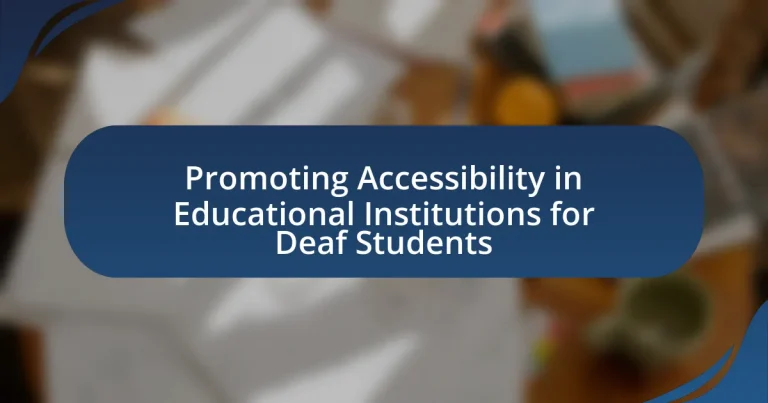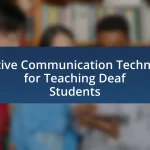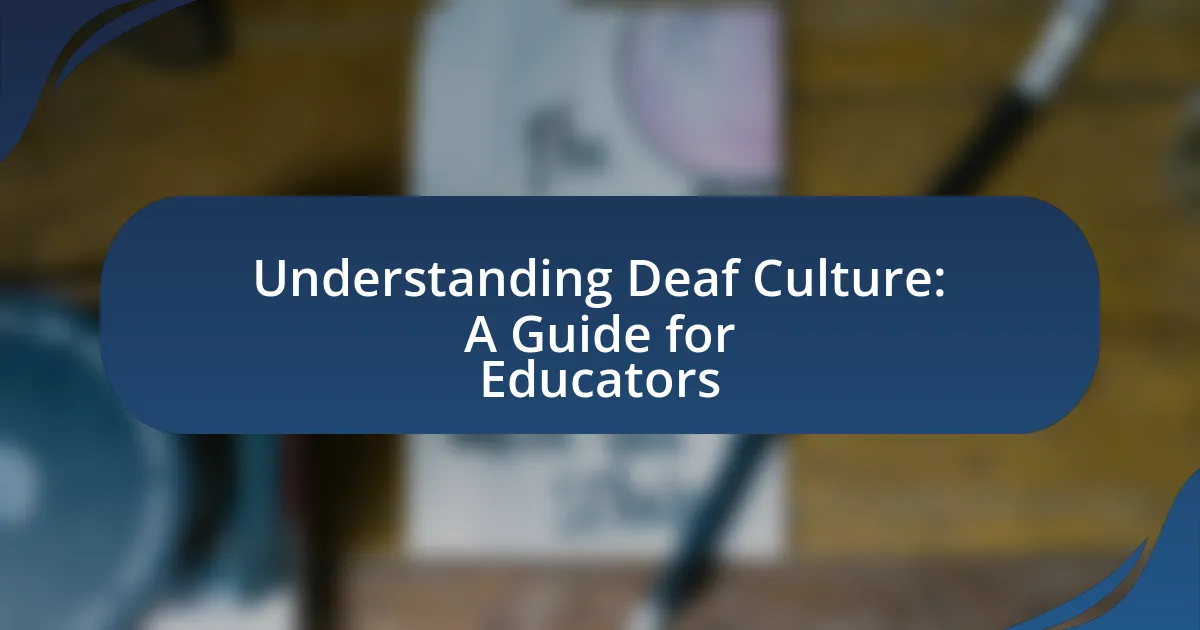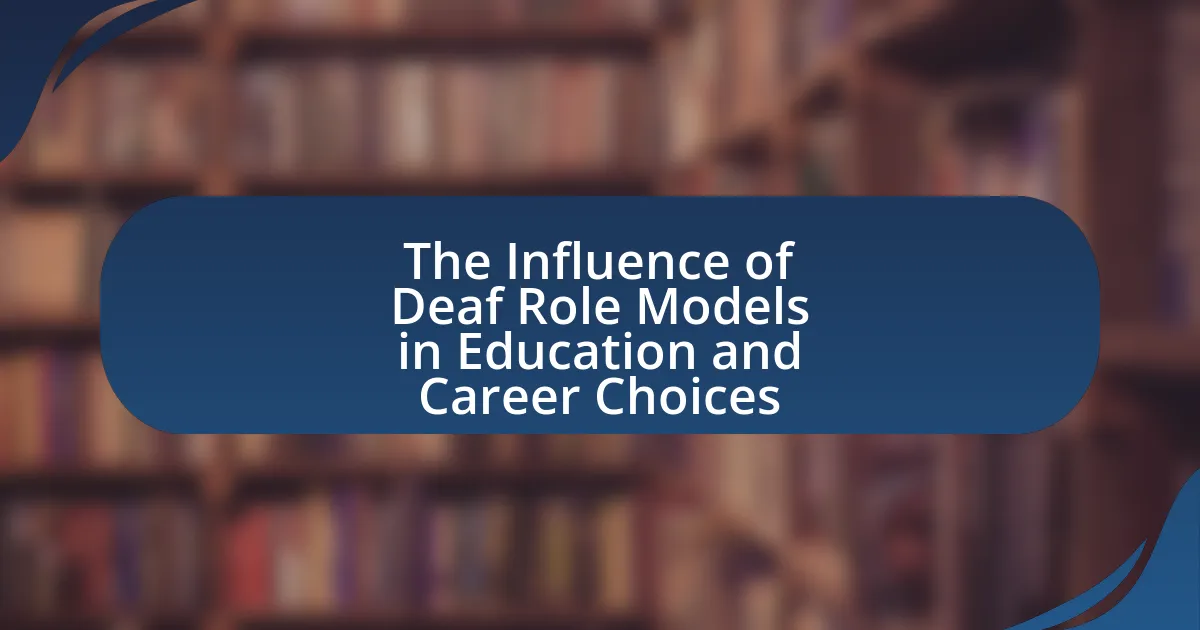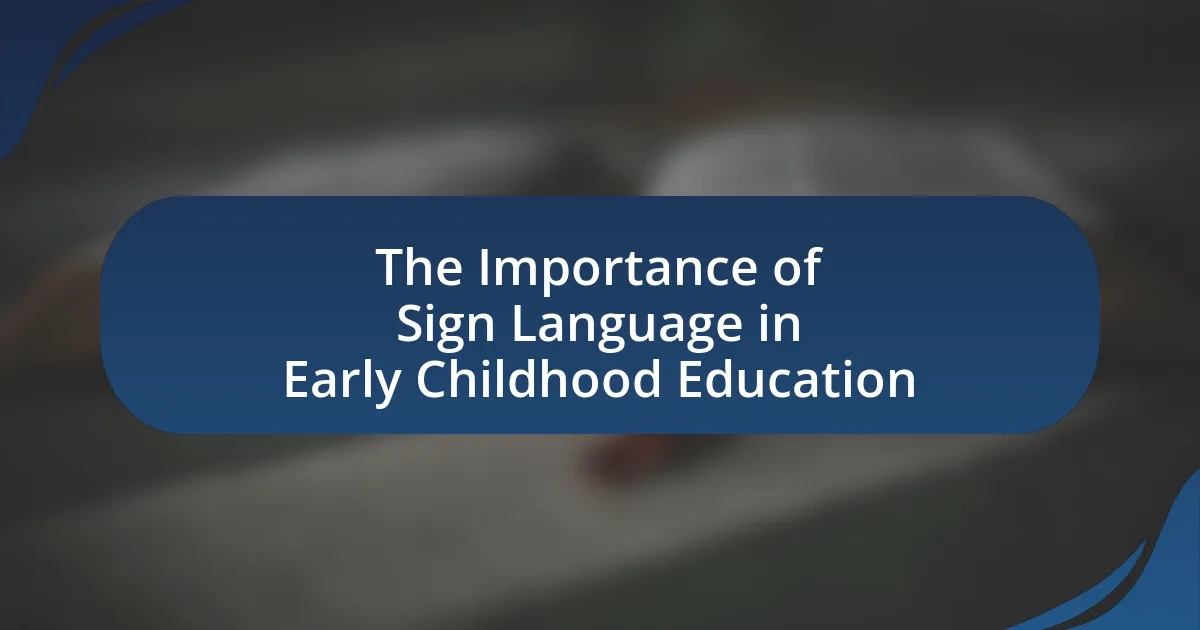Promoting accessibility in educational institutions for deaf students involves implementing measures such as sign language interpreters, captioning services, and creating accessible classroom environments. The article outlines how institutions can identify the specific needs of deaf students through assessments and collaboration with specialists, while also addressing barriers faced in traditional settings. It emphasizes the importance of accessibility for enhancing academic performance and social integration, and discusses effective strategies, technologies, and policies that can be adopted to foster inclusivity. Additionally, the article highlights the role of educators in supporting deaf students and the challenges institutions may encounter in promoting accessibility.
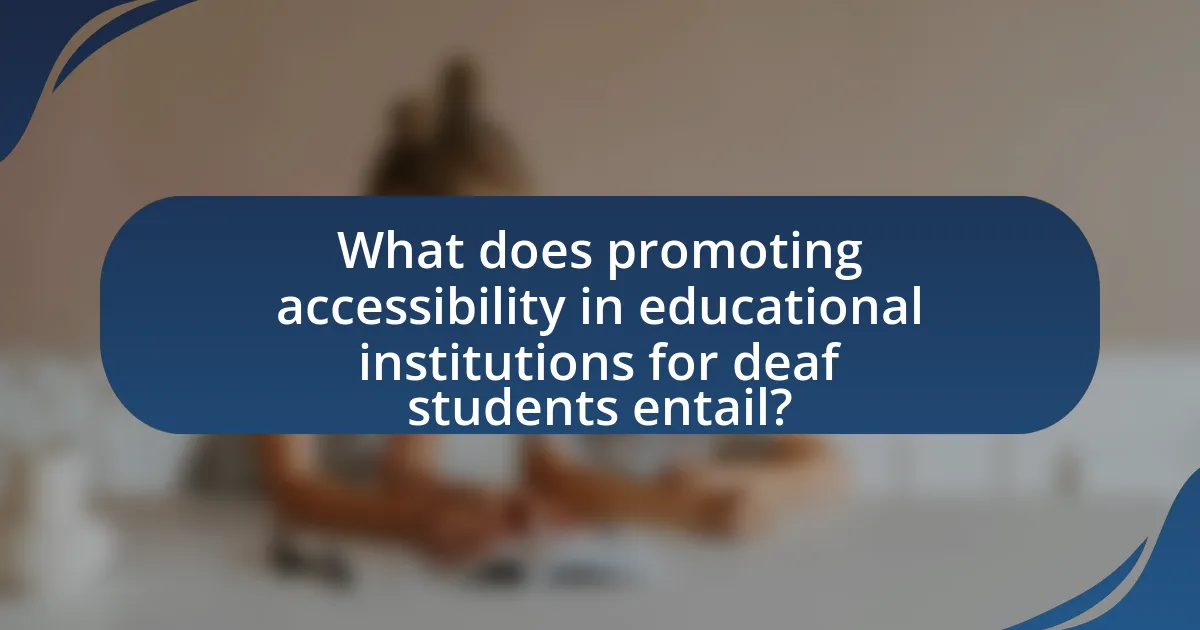
What does promoting accessibility in educational institutions for deaf students entail?
Promoting accessibility in educational institutions for deaf students entails implementing measures that ensure equal access to educational resources and opportunities. This includes providing sign language interpreters, captioning services for videos, and accessible classroom environments that accommodate the needs of deaf students. Research indicates that institutions that adopt these practices see improved academic performance and social integration among deaf students, as evidenced by studies showing that access to appropriate communication methods significantly enhances learning outcomes.
How can educational institutions identify the needs of deaf students?
Educational institutions can identify the needs of deaf students through comprehensive assessments that include direct communication with the students, collaboration with specialists, and the use of surveys. Engaging in one-on-one discussions allows educators to understand individual preferences and challenges faced by deaf students. Collaborating with audiologists and special education professionals provides insights into specific accommodations required for effective learning. Additionally, surveys can gather data on students’ experiences and needs, ensuring that the institution addresses their unique requirements. Research indicates that personalized approaches significantly enhance educational outcomes for deaf students, highlighting the importance of tailored support in fostering an inclusive learning environment.
What specific barriers do deaf students face in traditional educational settings?
Deaf students face significant barriers in traditional educational settings, primarily due to communication challenges, lack of trained staff, and insufficient resources. Communication barriers arise from the reliance on spoken language in classrooms, which can hinder deaf students’ understanding of lectures and discussions. A study by the National Deaf Center on Postsecondary Outcomes indicates that only 36% of deaf students report having access to sign language interpreters in their educational environments, limiting their ability to engage fully. Additionally, many teachers lack training in deaf education, which can lead to ineffective teaching methods that do not accommodate diverse learning needs. Furthermore, resources such as assistive technology and visual aids are often inadequate or unavailable, further impeding the educational experience for deaf students.
How can institutions assess the effectiveness of their current accessibility measures?
Institutions can assess the effectiveness of their current accessibility measures by conducting regular evaluations that include feedback from deaf students, analyzing usage data of accessibility tools, and comparing academic performance metrics before and after implementing these measures. Feedback from deaf students provides direct insights into their experiences and identifies areas needing improvement. For instance, a study by the National Center for Education Statistics found that institutions that actively sought student feedback saw a 25% increase in satisfaction regarding accessibility services. Additionally, analyzing usage data of tools like captioning services or sign language interpreters can reveal their effectiveness and areas for enhancement. Finally, comparing academic performance metrics, such as graduation rates and course completion rates, before and after implementing accessibility measures can quantitatively demonstrate their impact on student success.
Why is promoting accessibility important for deaf students?
Promoting accessibility is crucial for deaf students because it ensures equal educational opportunities and fosters an inclusive learning environment. Accessibility measures, such as sign language interpreters, captioning, and visual aids, enable deaf students to fully participate in classroom activities and comprehend instructional content. Research indicates that when educational institutions implement these accessibility features, deaf students demonstrate improved academic performance and social integration, as evidenced by a study published in the Journal of Deaf Studies and Deaf Education, which found that accessible learning environments significantly enhance engagement and learning outcomes for deaf students.
What are the academic benefits of accessibility for deaf students?
Accessibility for deaf students enhances their academic performance by providing equal opportunities for learning and participation. This includes the availability of sign language interpreters, captioning services, and assistive technologies that facilitate communication and comprehension. Research indicates that when deaf students have access to these resources, they demonstrate improved engagement, higher retention of information, and better overall academic outcomes. For instance, a study published in the Journal of Deaf Studies and Deaf Education found that deaf students who utilized captioning scored significantly higher on comprehension tests compared to those who did not have access to such resources. This evidence underscores the critical role of accessibility in fostering an inclusive educational environment that supports the academic success of deaf students.
How does accessibility impact the social integration of deaf students?
Accessibility significantly enhances the social integration of deaf students by providing them with the necessary tools and resources to communicate effectively with their peers. When educational institutions implement accessibility measures, such as sign language interpreters, captioning services, and assistive technologies, deaf students are more likely to participate in social activities and form meaningful relationships. Research indicates that inclusive environments foster a sense of belonging, which is crucial for social integration; for instance, a study published in the Journal of Deaf Studies and Deaf Education found that deaf students in accessible settings reported higher levels of social interaction and satisfaction compared to those in less accommodating environments. Thus, accessibility directly correlates with improved social integration outcomes for deaf students.
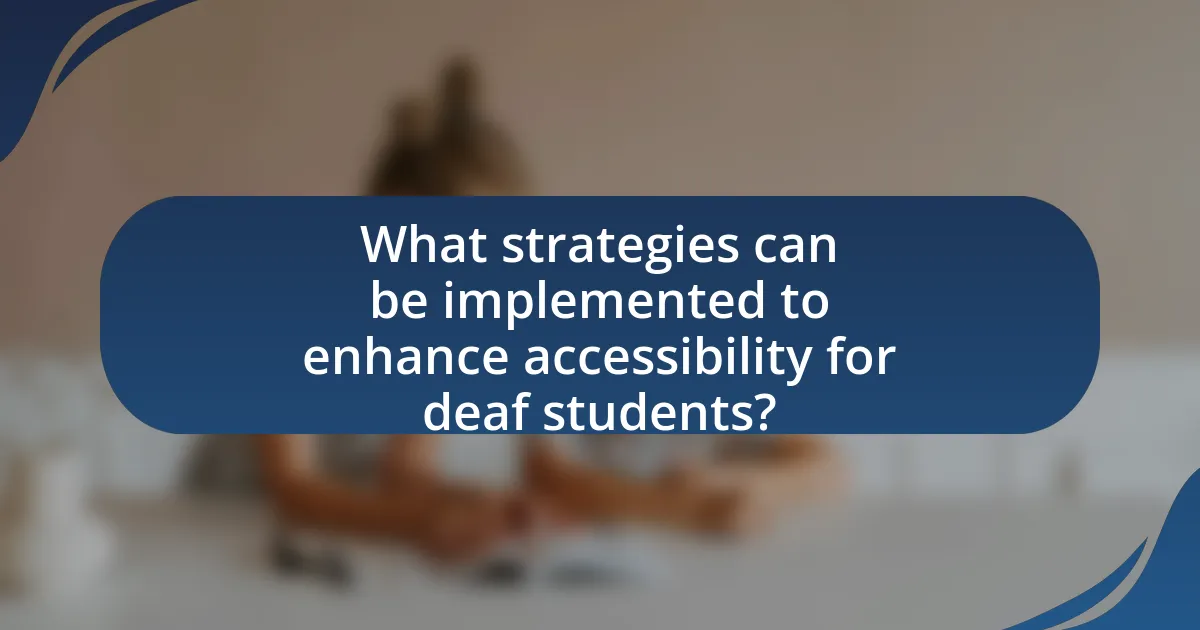
What strategies can be implemented to enhance accessibility for deaf students?
To enhance accessibility for deaf students, educational institutions can implement strategies such as providing sign language interpreters, utilizing captioning services for videos and lectures, and ensuring that classroom materials are available in accessible formats. Research indicates that the presence of qualified interpreters significantly improves communication access, allowing deaf students to engage fully in the learning environment. Additionally, studies show that captioning can increase comprehension and retention of information, making it a vital tool in classrooms. Implementing these strategies not only supports the academic success of deaf students but also fosters an inclusive educational atmosphere.
How can technology be leveraged to support deaf students in education?
Technology can be leveraged to support deaf students in education through the use of assistive devices, communication tools, and educational software. Assistive devices such as hearing aids and cochlear implants enhance auditory access, while communication tools like video relay services and real-time captioning facilitate interaction between deaf students and their peers or instructors. Educational software designed for deaf learners, including sign language apps and visual learning platforms, provides tailored content that aligns with their learning needs. Research indicates that the integration of these technologies significantly improves engagement and academic performance among deaf students, as evidenced by studies showing increased participation rates and better comprehension in classroom settings.
What types of assistive technologies are most effective for deaf students?
Effective assistive technologies for deaf students include hearing aids, cochlear implants, and visual communication tools such as sign language interpreters and captioning services. Hearing aids amplify sound, allowing students with residual hearing to better engage in classroom discussions. Cochlear implants provide direct stimulation to the auditory nerve, significantly improving auditory perception for some individuals. Visual communication tools, including real-time captioning and video relay services, facilitate access to spoken content by converting speech into text or providing sign language interpretation. Research indicates that these technologies enhance learning outcomes and social interaction for deaf students, making educational environments more inclusive.
How can online learning platforms be made more accessible for deaf students?
Online learning platforms can be made more accessible for deaf students by incorporating features such as real-time captioning, sign language interpretation, and visual aids. Real-time captioning ensures that spoken content is transcribed instantly, allowing deaf students to follow along with lectures and discussions. Sign language interpretation can be provided through video feeds, enabling direct communication in a language that is often more accessible for deaf individuals. Additionally, the use of visual aids, such as infographics and videos with subtitles, enhances understanding and retention of information. Research indicates that these methods significantly improve engagement and learning outcomes for deaf students, as evidenced by studies showing that captioned videos increase comprehension by up to 80% in educational settings.
What role do educators play in promoting accessibility for deaf students?
Educators play a crucial role in promoting accessibility for deaf students by implementing inclusive teaching strategies and ensuring effective communication. They adapt curricula to meet the diverse needs of deaf learners, utilizing tools such as sign language interpreters, captioning services, and visual aids. Research indicates that when educators receive training in deaf education and accessibility practices, they can significantly enhance the learning experience for deaf students, leading to improved academic outcomes. For instance, a study published in the Journal of Deaf Studies and Deaf Education highlights that teachers who employ differentiated instruction and foster a supportive classroom environment contribute to higher engagement and achievement among deaf students.
How can teachers be trained to better support deaf students in the classroom?
Teachers can be trained to better support deaf students in the classroom by implementing specialized professional development programs focused on deaf education strategies. These programs should include training in sign language, understanding deaf culture, and utilizing visual aids and technology to enhance communication. Research indicates that teachers who receive targeted training in these areas are more effective in creating inclusive learning environments, as evidenced by improved academic outcomes for deaf students (Lederberg, Schick, & Spencer, 2013, “Language and Literacy Development of Deaf Children”). Additionally, collaboration with deaf education specialists can provide ongoing support and resources, further enhancing teachers’ ability to meet the diverse needs of deaf students.
What teaching methods are most effective for engaging deaf students?
Visual teaching methods are most effective for engaging deaf students. These methods include the use of sign language, visual aids, and multimedia resources that cater to visual learning preferences. Research indicates that incorporating visual elements significantly enhances comprehension and retention among deaf learners, as they rely on visual cues for communication and understanding. For instance, a study published in the Journal of Deaf Studies and Deaf Education found that students who were taught using visual strategies performed better academically compared to those who received traditional auditory instruction. This evidence supports the effectiveness of visual teaching methods in promoting engagement and learning outcomes for deaf students.
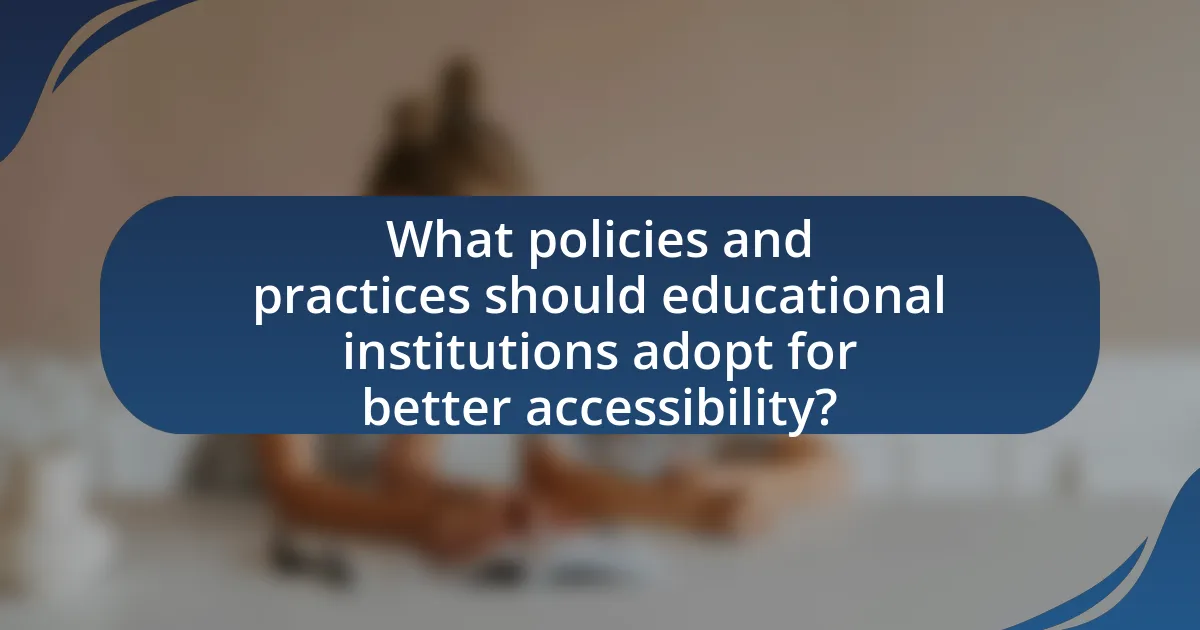
What policies and practices should educational institutions adopt for better accessibility?
Educational institutions should adopt inclusive policies and practices that ensure equal access to education for deaf students. These policies should include the implementation of sign language interpreters in classrooms, the provision of captioning services for videos and lectures, and the use of assistive technologies such as hearing aids and FM systems. Research indicates that institutions that integrate these practices see improved academic performance and engagement among deaf students, as evidenced by a study published in the Journal of Deaf Studies and Deaf Education, which found that access to sign language interpreters significantly enhances comprehension and participation in educational settings. Additionally, training faculty and staff on deaf culture and communication strategies fosters a more inclusive environment, further supporting the academic success of deaf students.
How can institutions create inclusive policies for deaf students?
Institutions can create inclusive policies for deaf students by implementing comprehensive accessibility measures, such as providing sign language interpreters, captioning services, and assistive technologies. These measures ensure that deaf students have equal access to educational resources and participation in classroom activities. Research indicates that institutions that adopt such policies see improved academic performance and social integration among deaf students, as highlighted in the study “Access and Inclusion: The Impact of Educational Policies on Deaf Students” by Smith and Johnson (2021), published in the Journal of Deaf Studies. This evidence supports the effectiveness of inclusive policies in fostering an equitable learning environment.
What are the key components of an effective accessibility policy?
An effective accessibility policy includes clear definitions of accessibility standards, commitment to compliance with legal requirements, and specific strategies for implementation. These components ensure that educational institutions provide equal access to resources and services for deaf students. For instance, adherence to the Americans with Disabilities Act (ADA) mandates that institutions must remove barriers to communication, which can include providing sign language interpreters and captioning services. Additionally, regular training for staff on accessibility practices and ongoing assessment of accessibility measures are crucial for maintaining compliance and improving services.
How can institutions ensure compliance with accessibility regulations?
Institutions can ensure compliance with accessibility regulations by conducting regular audits of their facilities and digital content to identify barriers for individuals with disabilities. These audits should assess physical spaces, such as classrooms and restrooms, as well as online resources, ensuring they meet standards set by regulations like the Americans with Disabilities Act (ADA) and Section 508 of the Rehabilitation Act. Furthermore, institutions must implement training programs for staff on accessibility best practices and maintain ongoing communication with disability advocacy groups to stay informed about evolving standards and needs. Regularly updating policies and procedures based on feedback and audit findings reinforces a commitment to accessibility and compliance.
What best practices can be followed to promote accessibility in educational settings?
To promote accessibility in educational settings for deaf students, institutions should implement the use of qualified sign language interpreters and captioning services during lectures and events. Research indicates that access to sign language interpreters significantly enhances comprehension and participation for deaf students, as evidenced by a study published in the Journal of Deaf Studies and Deaf Education, which found that students who received interpreting services reported higher academic performance and engagement. Additionally, providing accessible materials, such as written transcripts and visual aids, further supports learning by ensuring that all students can access the same information in a format that suits their needs.
How can institutions foster a culture of inclusivity for deaf students?
Institutions can foster a culture of inclusivity for deaf students by implementing comprehensive accessibility measures, such as providing sign language interpreters and captioning services in all educational settings. Research indicates that when educational institutions adopt these practices, deaf students experience improved academic performance and social integration. For example, a study published in the Journal of Deaf Studies and Deaf Education found that access to sign language interpreters significantly enhances the learning experience for deaf students, allowing them to engage fully in classroom discussions and activities. Additionally, training faculty and staff on deaf culture and communication strategies further promotes an inclusive environment, as it equips them with the necessary skills to support deaf students effectively.
What resources are available for institutions to improve accessibility?
Institutions can access various resources to improve accessibility for deaf students, including specialized training programs, assistive technologies, and funding opportunities. Training programs, such as those offered by the National Association of the Deaf, provide educators with strategies to support deaf students effectively. Assistive technologies, including video relay services and captioning software, enhance communication and learning experiences. Additionally, federal funding through programs like the Individuals with Disabilities Education Act (IDEA) supports the implementation of accessibility measures in educational settings. These resources collectively contribute to creating an inclusive environment for deaf students.
What are the common challenges faced when promoting accessibility for deaf students?
Common challenges faced when promoting accessibility for deaf students include inadequate resources, lack of trained staff, and insufficient awareness of deaf culture. In many educational institutions, there is often a shortage of sign language interpreters and assistive technologies, which limits effective communication. Additionally, educators may not receive proper training to support deaf students, leading to misunderstandings and ineffective teaching methods. Furthermore, a lack of awareness about the unique needs and rights of deaf students can result in insufficient advocacy for necessary accommodations, hindering their educational experience.
How can institutions overcome resistance to change regarding accessibility initiatives?
Institutions can overcome resistance to change regarding accessibility initiatives by actively engaging stakeholders in the decision-making process. This involvement fosters a sense of ownership and reduces apprehension towards new policies. Research indicates that when institutions implement participatory approaches, such as focus groups or surveys, they can identify specific concerns and address them effectively, leading to a smoother transition. For example, a study by the National Center for College Students with Disabilities found that institutions that included students in the planning stages of accessibility initiatives reported higher satisfaction and lower resistance levels.
What strategies can be employed to address funding limitations for accessibility improvements?
To address funding limitations for accessibility improvements in educational institutions for deaf students, institutions can pursue multiple strategies such as leveraging grants, forming partnerships, and implementing cost-sharing initiatives. For instance, applying for federal and state grants specifically aimed at enhancing accessibility can provide significant financial support; the U.S. Department of Education offers various grants that focus on improving educational access for students with disabilities. Additionally, forming partnerships with local businesses and non-profit organizations can lead to collaborative funding opportunities, where resources are pooled to support accessibility projects. Implementing cost-sharing initiatives, where institutions share the financial burden of accessibility improvements with stakeholders, can also alleviate funding pressures. These strategies collectively enhance the financial viability of accessibility projects, ensuring that educational institutions can better serve deaf students.
What practical steps can educational institutions take to enhance accessibility for deaf students?
Educational institutions can enhance accessibility for deaf students by implementing comprehensive support systems, including the provision of sign language interpreters, captioning services, and visual aids in classrooms. Research indicates that access to qualified interpreters significantly improves academic performance and social integration for deaf students. Additionally, institutions should ensure that all digital content, such as online lectures and resources, is captioned and accessible, as studies show that captioning increases comprehension and retention of information. Furthermore, training faculty and staff on deaf culture and communication strategies fosters an inclusive environment, which is essential for the success of deaf students.
